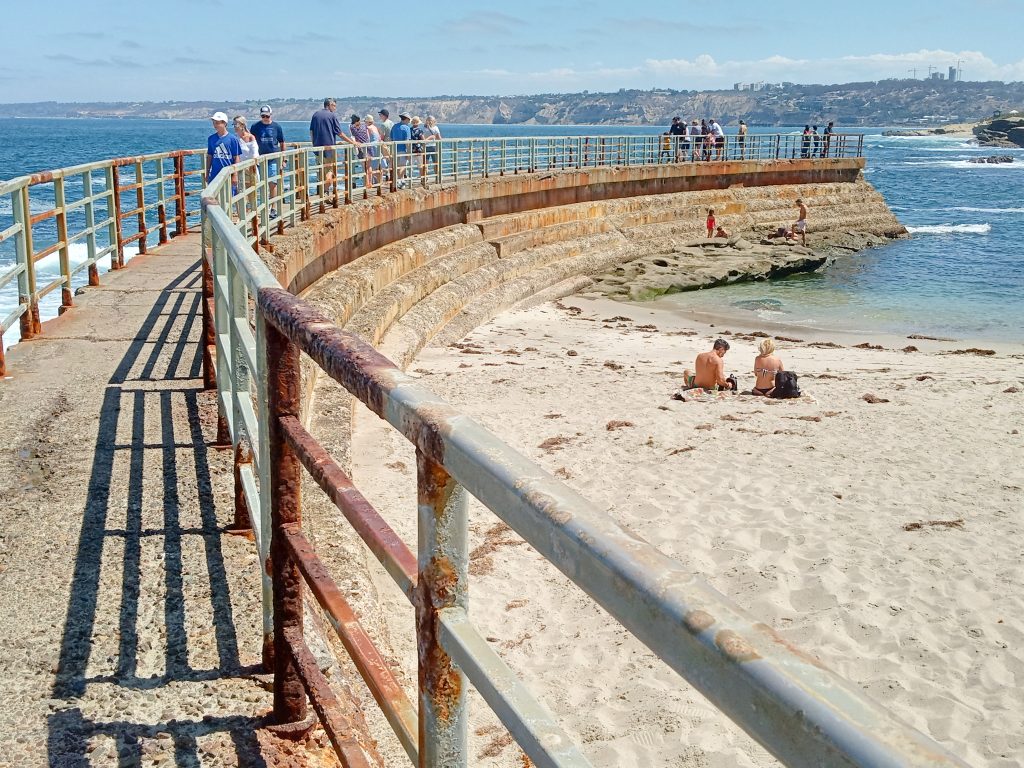
Looking ahead, an engineering study well underway is planning for needed repairs to the Children’s Pool seawall estimated to cost $2.3 million.
The study by MDEP Inc. engineering firm commissioned by La Jolla Parks and Beaches, Inc., is being paid for by leftover money from the Children’s Pool Plaza construction project finished in 2018. LJP&B makes recommendations to the City on coastal parks in the Jewel.
LJP&B received an update recently on the project by Matt Mangano from MDEP Inc. “We are looking at a seawall itself that is nearly 100 years old, and we are designing for another 100-plus years,” Mangano said. “The big challenge is going to be the adherence (of the seawall to the reef). So, whatever the new concrete is, it needs to be better than the existing concrete. So, we’re going to have to prepare the surface (of the seawall) then come in with the latest, newest technology (for repairs).”
MDEP said they would be using the Army Corps of Engineers’ inspection techniques and their manuals on designing seawalls. Much of what needs to be done is easy to see, Mangano said.
“Anyone who has been down there is familiar with the degradation and the erosion that is occurring on the (seawall’s) stairwell, which is a shame for the access and there will be a challenge to (repairing) it,” he said. He added that waterproofing will be key to successfully repairing the seawall. “Any sort of waterproofing we can do on the wall has a lot to do with the porousness of the concrete,” he said. “So, with the repairs, there is going to need to be some sort of demolition.”
Mangano pointed out engineers are “going to have to make some strong educated guesses” about the stability of the seawall while working to reinforce it. “We’re not going to cut the wall open and travel through it to see,” he said adding how much work needs to be done could largely be determined by “the interior (of the wall) and how that has all held up.”

Referring to the seawall’s original design, Mangano said: “It really was an amazing process to have the concrete really become part of the reef from an engineering perspective.” He added, “We’re going to be recommending reconstructing the steps into the water for children to actually use to swim.”
LJP&B members expressed approval of the Children’s Pool seawall-repair project.
“Ellen Browning Scripps would be so proud,” said Melinda Merryweather.
“This is an underlying feature of our local community here,” said Phyllis Minick, who spearheaded the Children’s Pool Plaza construction project. “People who come here from other parts of the world, the first thing they ask for is to go to Children’s Pool and the Cove. So, to reinforce these features, and make them available for the future, is incredibly important.”
DO’S AND DON’TS
– The seawall is nearly 100 years old and it’s an uneven path so unsteady walkers should take heed.
– While you gaze at the seals, be mindful of the ocean behind you as it’s not uncommon for the surf to pound the sea wall and startle you with a splash. Be mindful of what you are hand-carrying because it would be easy to drop your phone if this happened.
– Don’t wear a backpack or carry a bulky bag as it will be hard to pass by others on the seawall as the walkway is narrow.
– Keep an eye on young children as the fence slats are wide.
HISTORY OF CHILDREN’S POOL
While the Children’s Pool, a small sandy beach at 850 Coast Blvd. at the end of Jenner Street in La Jolla, had attracted visitors since the 1870s, for several decades afterward, its coast and surf developed a reputation for danger. By the early 1900s, visitors were being warned not to go into the ocean at La Jolla’s many beaches here because of the hazardous cross currents. In 1921, Ellen Browning Scripps, a wealthy La Jollan since 1897, who had focused much of her life and philanthropy on the welfare of children in the community, sought to resolve this ongoing problem.
She hired a hydraulic engineer named Hiram Savage to conduct a survey for the construction of a proposed breakwater somewhere in La Jolla to create an area where it would be safe for children to go in the ocean. In 1923, Savage submitted his results, proposing that a crescent-shaped breakwater be constructed where the Children’s Pool beach is today.
Scripps paid for the construction of a breakwater project in order to create a place where children could play and swim that would be protected from waves coming onshore. In May 1931, a public celebration was held to commemorate the completion of the new breakwater, and the safe ocean bathing area for children it created, all of which had been gifted by Scripps to La Jolla. Scripps was too ill to attend the public celebration herself, unfortunately, and she died in 1932. But the Children’s Pool remains another lasting legacy of her local philanthropy.









